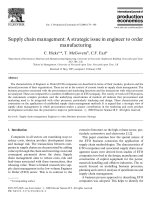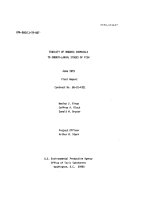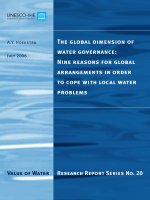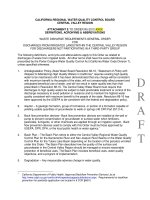ATTACHMENT E TO ORDER R5-2012-XXXX DEFINITIONS, ACRONYMS & ABBREVIATIONS pot
Bạn đang xem bản rút gọn của tài liệu. Xem và tải ngay bản đầy đủ của tài liệu tại đây (92.09 KB, 9 trang )
D
R
A
F
T
CALIFORNIA REGIONAL WATER QUALITY CONTROL BOARD
CENTRAL VALLEY REGION
ATTACHMENT E TO ORDER R5-2012-XXXX
DEFINITIONS, ACRONYMS & ABBREVIATIONS
WASTE DISHARGE REQUIREMENTS GENERAL ORDER
FOR
DISCHARGES FROM IRRIGATED LANDS WITHIN THE CENTRAL VALLEY REGION
FOR DISCHARGERS NOT PARTICIPATING IN A THIRD-PARTY GROUP
The following definitions, acronyms and abbreviations apply to this Order as related to
discharges of waste from irrigated lands. All other terms shall have the same definitions as
prescribed by the Porter-Cologne Water Quality Control Act (California Water Code Division 7),
unless specified otherwise.
1. Antidegradation Policy–State Water Board Resolution 68-16, "Statement of Policy with
Respect to Maintaining High Quality Waters in California," requires existing high quality
water to be maintained until it has been demonstrated that any change will be consistent
with maximum benefit to the people of the state, will not unreasonably affect present and
anticipated beneficial use of water, and will not result in water quality less than that
prescribed in Resolution 68-16. The Central Valley Water Board must require that
discharges to high quality waters be subject to best practicable treatment or control of the
discharge necessary to avoid pollution or nuisance and to maintain the highest water
quality consistent with maximum benefit to the people of the state. Resolution 68-16 has
been approved by the USEPA to be consistent with the federal anti-degradation policy.
2. Aquifer – A geologic formation, group of formations, or portion of a formation capable of
yielding usable quantities of groundwater to wells or springs (40 CFR Part 257.3-4).
3. Back flow prevention devices– Back flow prevention devices are installed at the well or
pump to prevent contamination of groundwater or surface water when fertilizers,
pesticides, fumigants, or other chemicals are applied through an irrigation system. Back
flow prevention devices used to comply with this Order must be those approved by
USEPA, DPR, DPH, or the local public health or water agency.
1
4. Basin Plan – The Basin Plan refers to either the Central Valley Regional Water Quality
Control Plan for the Sacramento River and San Joaquin River Basins or the Water Quality
Control Plan for the Tulare Lake Basin depending on the location of the parcel(s) enrolled
under this Order. The Basin Plan describes how the quality of the surface and
groundwater in the Central Valley Region should be managed to ensure reasonable
protection of beneficial uses. The Basin Plan includes beneficial uses, water quality
objectives, and a program of implementation.
5. Degradation – Any measurable adverse change in water quality.
1
California Department of Public Health, Approved Backflow Prevention Devices List at
Requirements for backflow
prevention for pesticide application are located in 6 CCR §6610.
Attachment E to Order R5-2012-XXXX - Definitions 2
Individual Discharger General Order
D
R
A
F
T
6. Exceedance – For the purposes of this Order, an exceedance is a reading using a field
instrument or detection by a California state-certified analytical laboratory where the
detected result indicates an impact to the beneficial use of the receiving water when
compared to a water quality objective for the parameter or constituent. Exceedances will
be determined based on available data and application of the appropriate averaging
period. The appropriate averaging period may be defined in the Basin Plan, as part of the
water quality criteria established by the USEPA, or as part of the water quality criteria
being used interpret a narrative water quality objective. If averaging periods are not
defined as part of the water quality objective or the water quality criteria being used, then
the Central Valley Water Board may use its best professional judgment to determine an
appropriate period.
7. Farming Operation – A distinct farming business, organized as a sole proprietorship,
partnership, corporation, limited liability company, cooperative, or other business entity
that owns or operates irrigated lands.
8. Farm Operator – The person or entity, including, but not limited to a farm/ranch manager,
lessee or sub-lessee, responsible for or otherwise directing farming operations in
decisions that may result in a discharge of waste to surface water or groundwater. If a
person or entity rents land to others or has land worked on shares by others, the person or
entity is considered the operator only of the land which is retained for their own operation.
9. Fertigation -– The process of applying fertilizer through an irrigation system by injecting
the fertilizer into the irrigation water.
10. Field – A field is any distinctly managed contiguous section of agricultural land. A field
may contain a row crop, vineyard, orchard, pasture, etc. A farm often has multiple fields,
which may or may not each contain the same crop. A field is often bordered on at least
one side by a dirt road and/or an irrigation ditch or drainage ditch.
11. Groundwater – Water in the ground that is in the zone of saturation. The upper surface of
the saturated zone is called the water table.
12. Impaired water body – A surface water body that is not attaining water quality standards
and is identified on the State Water Board’s Clean Water Act section 303(d) list.
13. Irrigated lands – Land irrigated to produce crops or pasture for commercial purposes
2
;
nurseries; and privately and publicly managed wetlands.
2
For the purposes of this Order, commercial irrigated lands are irrigated lands that have one or
more of the following characteristics:
• The landowner or operator holds a current Operator Identification Number/ Permit
Number for pesticide use reporting;
• The crop is sold to a third party including, but not limited to, (1) an industry cooperative,
(2) harvest crew/company, or (3) a direct marketing location, such as farmers’ markets;
• The landowner or operator files federal taxes using federal Department of Treasury
Internal Revenue Service Form 1040, Schedule F Profit or Loss from Farming.
Attachment E to Order R5-2012-XXXX - Definitions 3
Individual Discharger General Order
D
R
A
F
T
14. Irrigation return flow/runoff – Surface and subsurface water which leaves the field following
application of irrigation water.
15. Management practices– A practice or combination of practices that is the most effective
and practicable (including technological, economic, and institutional considerations)
means of controlling nonpoint pollutant sources at levels protective of water quality.
16. Monitoring – Monitoring undertaken in connection with assessing water quality conditions,
and factors that may affect water quality conditions. Monitoring includes, but is not limited
to, water quality monitoring undertaken in connection with agricultural activities, monitoring
to identify short and long-term trends in water quality, nutrient monitoring, active
inspections of operations, and management practice implementation and effectiveness
monitoring. The purposes of monitoring include, but are not limited to, verifying the
adequacy and effectiveness of the Order’s requirements, and evaluating each
Discharger’s compliance with the requirements of the Order.
17. Nonpoint source waste discharge– The Sacramento and San Joaquin River Basin Plan
states that “A nonpoint source discharge usually refers to waste emanating from diffused
locations.”
Nonpoint source pollution generally results from land runoff, precipitation,
atmospheric deposition, drainage, seepage or hydrologic modification. The term "nonpoint
source" is defined to mean any source of water pollution that does not meet the legal
definition of "point source" in section 502(14) of the Clean Water Act.
The Clean Water
Act (CWA) defines a point source as a discernible, confined, and discrete conveyance,
such as a pipe, ditch, or channel. Irrigated agricultural return flows and agricultural storm
water runoff are excluded from the CWA’s definition of point source.
18. Nuisance – “Nuisance” is defined at section 13050 of the Water Code as “…anything
which meets all of the following requirements:
(1) Is injurious to health, or is indecent or offensive to the senses, or an obstruction to the
free use of property, so as to interfere with the comfortable enjoyment of life or
property.
(2) Affects at the same time an entire community or neighborhood, or any considerable
number of persons, although the extent of the annoyance or damage inflicted upon
individuals may be unequal.
(3) Occur during, or as a result of, the treatment or disposal of wastes.”
19. Off-property discharge – The discharge or release of waste beyond the boundaries of the
agricultural operation or to water bodies that run through the agricultural operation.
20. Perched groundwater – Groundwater separated from an underlying body of groundwater
by an unsaturated zone.
21. Pollution – Defined in Section 13050(l)(1) of the Porter-Cologne Water Quality Control Act
as “…an alteration of the quality of the waters of the state by waste to a degree which
unreasonably affects either of the following: (A) The waters for beneficial uses. (B)
Facilities which serve these beneficial uses.”
22. Receiving waters – Surface water or groundwater that receives discharges of waste from
irrigated lands.
Attachment E to Order R5-2012-XXXX - Definitions 4
Individual Discharger General Order
D
R
A
F
T
23. Requirements of applicable water quality control plans – Water quality objectives,
prohibitions, total maximum daily load implementation plans, or other requirements
contained in water quality control plans adopted by the Central Valley Water Board and
approved according to applicable law.
24. Rubbish, refuse, or other solid waste – Examples of this type of waste include, but are not
limited to metal, plastic, glass, paper, tires, deceased animals, containers, garbage, and
crop vegetative waste.
25. Salt – The products other than water of the reaction of an acid with a base. Salts
commonly break up into cations (positively charged ions) such as sodium, calcium, etc.
and anions (negatively charged ions) such as chloride, sulfate, etc. when dissolved in
water. Total dissolved solids and electrical conductivity are used as general estimate of
the amount of salts in a water or wastewater.
26. Significant storm event – A precipitation event that results in continuous runoff of storm
water for a minimum of one hour, or intermittent discharge of runoff for a minimum of three
hours in a 12-hour period.
27. Storm season (wet season) – The portion of the year in which the majority of precipitation
falls. Within the Central Valley, the storm season is the period of time between 1 October
and 30 April each year, with the peak storm season typically occurring February through
March.
28. Stormwater runoff – The runoff of precipitation from irrigated lands.
29. Subsidiary or Affiliated Operation – a Subsidiary or Affiliated Operation of a specified
Farming Operation means a Farming Operation of which the principal(s) of the specified
Farming Operation or the shares possessed by the specified Farming Operation have a
controlling interest. A controlling interest is having 50 percent or more of the voting or
management authority of the operation.
30. Subsurface drainage – Water generated by installing and operating drainage systems to
lower the water table below irrigated lands. Subsurface drainage systems, deep open
drainage ditches, or drainage wells can generate this drainage.
31. Surface water – Water pooled or collected at or above ground level. Surface waters
include, but are not limited to, natural streams, lakes, wetlands, creeks, constructed
agricultural drains, agricultural dominated waterways, irrigation and flood control channels,
or other non-stream tributaries. Surface waters include all waters of the United States and
their tributaries, interstate waters and their tributaries, intrastate waters, and all
impoundments of these waters. For the purposes of this Order, surface waters do not
include water in agricultural fields.
32. Tailwater – The runoff of irrigation water from an irrigated field.
33. Total Maximum Daily Load (TMDL) - From the Code of Federal Regulations (CFR), 40
CFR 130.2(i), a TMDL is: “The sum of the individual WLAs [wasteload allocations] for point
sources and LAs [load allocations] for nonpoint sources and natural background. …
TMDLs can be expressed in terms of either mass per time, toxicity, or other appropriate
measure. …”.
Attachment E to Order R5-2012-XXXX - Definitions 5
Individual Discharger General Order
D
R
A
F
T
34. Toxicity – Refers to the toxic effect to aquatic organisms from waste contained in an
ambient water quality sample.
35. Unsaturated Zone – The unsaturated zone is characterized by pore spaces that are
incompletely filled with water. The amount of water present in an unsaturated zone varies
widely and is highly sensitive to climatic factors.
36. Vadose Zone – See unsaturated zone.
37. Waste – Is defined as set forth in California Water Code section 13050(d). “Waste” includes
sewage and any and all other waste substances, liquid, solid, gaseous, or radioactive,
associated with human habitation, or of human or animal origin, or from any producing,
manufacturing, or processing operation, including waste placed within containers of
whatever nature prior to, and for purposes of, disposal. Wastes from irrigated lands that
conform to this definition include, but are not limited to, earthen materials (such as soil, silt,
sand, clay, rock), inorganic materials (such as metals, salts, boron, selenium, potassium,
nitrogen, phosphorus), organic materials such as pesticides, and biological materials, such
as pathogenic organisms. Such wastes may directly impact beneficial uses (e.g., toxicity of
metals to aquatic life) or may impact water temperature, pH, and dissolved oxygen.
38. Waste discharges from irrigated lands – The discharge or release of waste to surface water
or groundwater. Waste discharges to surface water include, but are not limited to, irrigation
return flows, tailwater, drainage water, subsurface (tile) drains, stormwater runoff flowing
from irrigated lands, aerial drift, and overspraying of pesticides. Waste can be discharged to
groundwater through pathways including, but not limited to, percolation of irrigation or storm
water through the subsurface, backflow of waste into wells (e.g., backflow during
chemigation), discharges into unprotected wells and dry wells, and leaching of waste from
tailwater ponds or sedimentation basins to groundwater.
A discharge of waste subject to the Order is one that could directly or indirectly reach
waters of the state, which includes both surface waters and groundwaters. Direct
discharges may include, for example, discharges directly from piping, tile drains, wells,
ditches or sheet flow to waters of the state, or percolation of wastes through the soil to
groundwater. Indirect discharges may include aerial drift or discharges from one parcel to
another parcel and then to waters of the state. See also the definition for “waste”.
39. Waters of the State – Is defined in Water Code section 13050 as “any surface water or
groundwater, including saline waters, within the boundaries of the State.”
40. Water Quality Criteria – Levels of water quality required under Section 303(c) of the Clean
Water Act that are expected to render a body of water suitable for its designated uses.
Criteria are based on specific levels of pollutants that would make the water harmful if
used for drinking, swimming, farming, fish production, or industrial processes. The
California Toxics Rule adopted by USEPA in April 2000 sets numeric water quality criteria
for non-ocean waters of California for a number of toxic pollutants.
41. Water Quality Objectives – Defined in Water Code section 13050 as “limits or levels of
water quality constituents or characteristics which are established for the reasonable
protection of beneficial uses of water or the prevention of nuisance within a specified
Attachment E to Order R5-2012-XXXX - Definitions 6
Individual Discharger General Order
D
R
A
F
T
area.” Water quality objectives may be either numerical or narrative and serve as water
quality criteria for purposes of section 303 of the Clean Water Act.
42. Water quality problem – Exceedance of an applicable water quality objective or trigger
level.
43. Water Quality Standards – Provision of State or Federal law that consist of the designated
beneficial uses of a waterbody, the numeric and narrative water quality criteria that are
necessary to protect the uses of that particular waterbody, and an anti-degradation
statement. Water quality standards include water quality objectives in the Central Valley
Water Board’s two Basin Plans, water quality criteria in the California Toxics Rule and
National Toxics Rule adopted by USEPA, and/or water quality objectives in other
applicable State Water Board plans and policies. Under Section 303 of the Clean Water
Act, each state is required to adopt water quality standards.
Attachment E to Order R5-2012-XXXX - Definitions 7
Individual Discharger General Order
D
R
A
F
T
Acronyms and Abbreviations
2008 Farm Bill
Food, Conservation, and Energy Act of 2008
AMR
annual monitoring report
Basin Plan
Water Quality Control Plan for the Sacramento and San Joaquin
River Basins (4
th
Ed.)
BPTC
best practicable treatment or control
CAC
county agricultural commissioner
CCR
California Code of Regulations
CDFA
California Department of Food and Agriculture
CEDEN
California Environmental Data Exchange Network
Central Valley Water
Board
California Regional Water Quality Control Board, Central Valley
Region
CEQA
California Environmental Quality Act
cfs
cubic feet per second
COC
constituent of concern
CRHR
California Register of Historic Resources
CTR
California Toxics Rule
CV RDC
Central Valley Regional Data Center
CV-SALTS
Central Valley Salinity Alternatives for Long-Term Sustainability
CWC
California Water Code
DO
dissolved oxygen
DPH
California Department of Public Health
DPM
diesel particulate matter
DPR
California Department of Pesticide Regulation
DWR
California Department of Water Resources
ECR
Existing Conditions Report
EDD
electronic data deliverable
EIR
environmental impact report
EPA
U.S. Environmental Protection Agency
EQIP
Environmental Quality Incentives Program
ESA
federal Endangered Species Act
ESI
Electronic Submittal of Information (Geotracker ESI)
FREP
Fertilizer Research and Education Program
FWQP
farm water quality plan
GeoTracker ESI
GeoTracker Electronic Submittal of Information Online System
GIS
Geographic Information System
GPS
Global Positioning System
GQMP
groundwater quality management plan
GWEP
groundwater exceedance plan
GWPA
groundwater protection area
HAPs
hazardous air pollutants
ILRP
Long-Term Irrigated Lands Regulatory Program
MDL
method detection limit
mg/L
milligrams per liter
MLD
most likely descendant
Attachment E to Order R5-2012-XXXX - Definitions 8
Individual Discharger General Order
D
R
A
F
T
MMRP
mitigation monitoring and reporting program
MPN
most probable number
MRP
monitoring and reporting program
MWICR
Monitoring Well Installation Completion Report
MWISP
Monitoring Well Installation and Sampling Plan
NAD83
North American Datum 1983
NAHC
Native American Heritage Commission
NAVD88
North American Vertical Datum 1988
NMFS
National Marine Fisheries Service
NOA
Notice of Applicability
NOI
Notice of Intent
NOT
Notice of Termination
NPDES
National Pollutant Discharge Elimination System
NPS
nonpoint source
NPS Policy
State Water Board’s Policy for Implementation and Enforcement of
the Nonpoint Source Pollution Control Program
NRCS
Natural Resource Conservation Service
NRHP
National Register of Historic Places
NTR
National Toxics Rule
NTU
Nephelometric Turbidity Units
PAMs
polyacrylamides
PCPA
Pesticide Contamination and Prevention Act
PEIR
Long-Term Irrigated Lands Regulatory Program Final Program EIR
(Final and Draft) (Certified by Resolution R5-2011-0017)
PRC
California Public Resources Code
PUR
Pesticide Use Report, CA DPR
QAPP
Quality Assurance Project Plan
QA/QC
quality assurance and quality control
RL
reporting limit
RWD
report of waste discharge
SB
Senate Bill
SIP
Policy for Implementation of Toxics Standards for Inland Surface
Waters, Enclosed Bays, and Estuaries of CA (State
Implementation Plan)
SM
Standard Methods
State Water Board
State Water Resources Control Board
SWAMP
Surface Water Ambient Monitoring Program
SWEP
surface water exceedance plan
TAC
toxic air contaminant
TDS
total dissolved solids
TMDL
total maximum daily load
TST
Test of Significant Toxicity (USEPA method)
μS/cm
microsiemens per centimeter
USACE
U.S. Army Corps of Engineers
USEPA
U.S. Environmental Protection Agency
USFWS
U.S. Fish and Wildlife Service
Attachment E to Order R5-2012-XXXX - Definitions 9
Individual Discharger General Order
D
R
A
F
T
WDRs
waste discharge requirements









